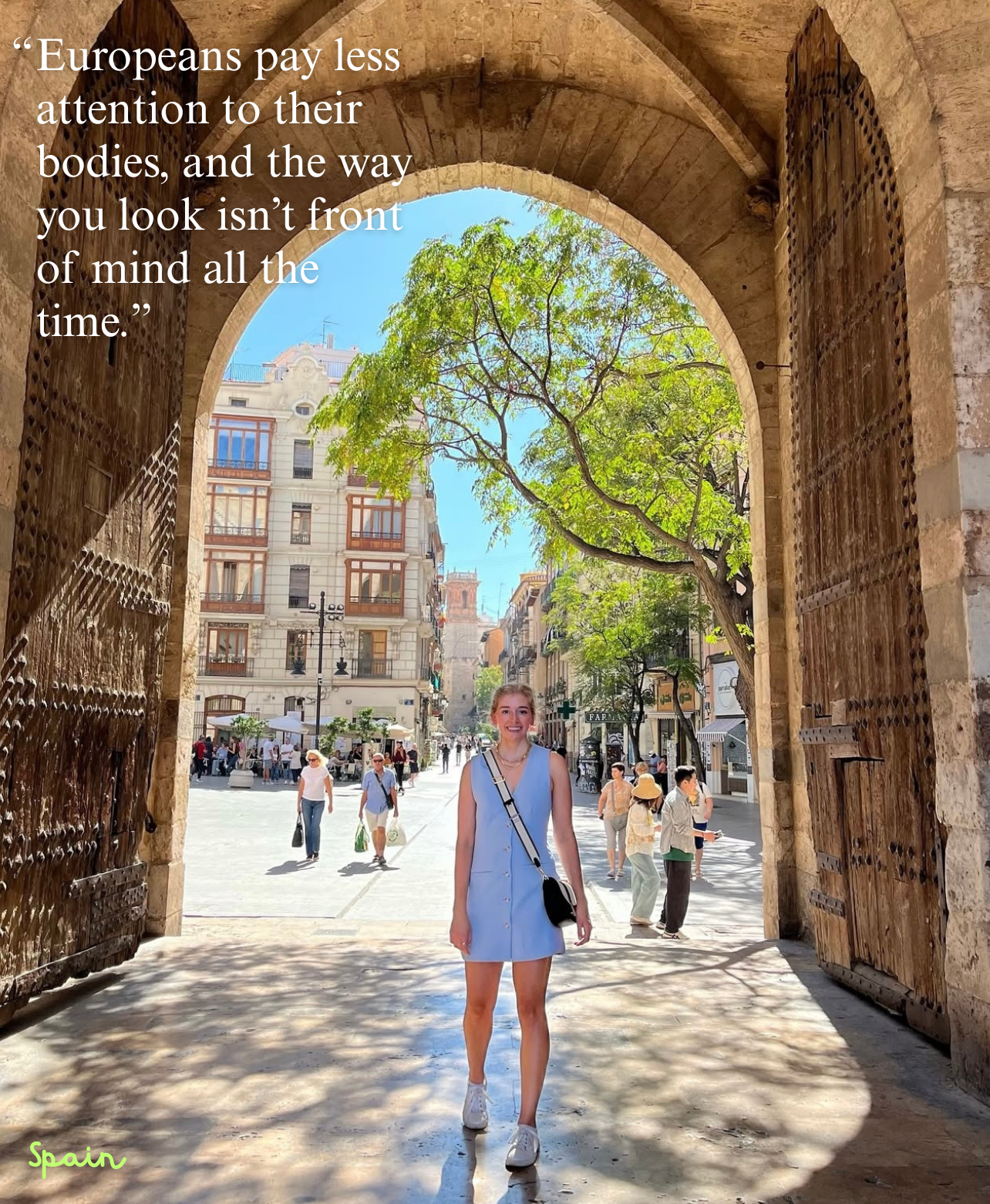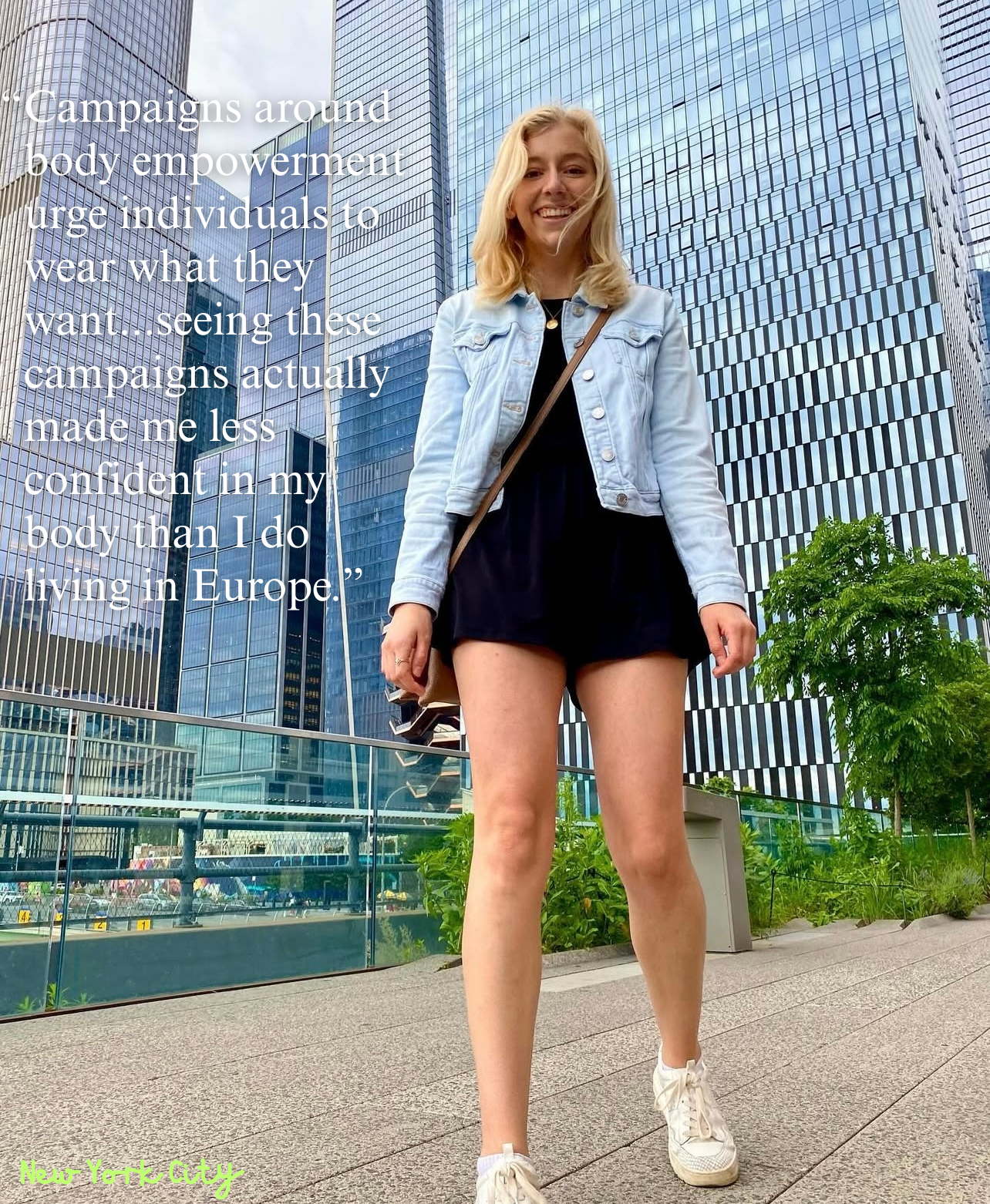What Dressing Abroad Taught Me About the Power of Clothes
Moving to Europe as an American means adjusting in unexpected ways, from learning to speak softly (Europeans have a saying that you can hear an American before you see them) to adjusting to the infamous European stare in public. But one of the most tangible shifts was learning to dress like a European. As a solo female traveler, blending in with locals felt crucial for both safety and confidence, so I made mastering European style a priority. After two years of living abroad, I’ve adapted my fashion sense to fit the European look. Now based in Austria, the greatest compliment I can receive is when locals approach me and speak in German first. To me, that means I officially look European enough that they didn’t automatically switch to English— a reminder of how non-verbal cues shape first impressions. Just by scanning a crowd, I can usually pick the Americans out. (Hint: they normally have on leggings or a baseball cap.)
What we wear shapes how we present to the world, but it also shapes how we view ourselves. Fashion can affect our mindset, confidence, and daily mood. Europeans and Americans have different fashion norms, but they also espouse different attitudes and approaches to life. In this article, we’ll explore how their styles differ, dive into the psychology behind them, and show how intentional dressing can become a form of self-care.
The Power of European Fashion Norms
In much of Central Europe, looking put together is part of the daily routine. I’m writing this article in leggings and a sweatshirt with my hair in a messy bun, but if I needed to leave my apartment, even if it’s just to run to the pharmacy, I’d have to change. I would quickly feel out of place walking down the street without a proper outfit and my hair done. At first, this felt like an inconvenience. Ugh, I have to put on jeans just to go pick up eggs! But over time, I adjusted and now I enjoy looking pulled together whenever I leave the house. It slightly elevates the mundane tasks and makes me feel good.
Key Characteristics of European Fashion
Effortless Elegance: Clothing leans towards classic cuts and clean lines, neutral palettes, and quality fabrics. Think flowy linen trousers, tailored button-up, and sleek, comfortable shoes. Long skirts and dresses made of natural fibers are also popular.
Conservative Silhouettes: European fashion also leans more conservative. Tight spandex outfits are not mainstream in Europe. Leggings are rarely worn outside the fitness studio. Crop tops and micro shorts are typically confined to beach clubs in places like Ibiza or Mallorca, but are certainly not daily wear—partly because Europeans find such styles to be tacky and at odds with the deep religious history found in Europe. With centuries-old cathedrals, mosques, and temples scattered across Europe, showing too much skin never became a common practice. It’s still expected to dress respectfully at religious sites. I’ve seen tourists turned away for wearing low-cut tops.
Natural Beauty Emphasis: While hair and makeup are expected to be “done”, the look is understated. You won’t see as many women with Botox, fillers, lip flips, fake lashes, or hair extensions. The aesthetic embraces timeless beauty.
Psychological Impact of Dressing Up
Dressing intentionally each day influences more than image. It guides our internal dialogue and confidence. In a study led by Abraham Rutchick, a professor of psychology at California State University, wearing well-coordinated, thoughtful attire was found to boost cognitive performance, feelings of power, and self-esteem. Often worn to follow norms or show respect, formal attire was shown to influence how we think. This aligns with findings linking dressy clothing to broader, more abstract thinking, and many participants noticed a tangible shift in mood when wearing formal attire. In other words, focusing on the bigger story we want to project leaves little room for nitpicking or minor worries.
I notice myself standing taller, feeling more open to opportunities, and generally approaching my day with more energy when I put effort into my appearance.
The Power of American Fashion Norms
After so much time living abroad, I have reverse culture shock returning to the United States. It catches me off guard to see so many women living their lives in leggings and crop tops. However, in America, it’s perfectly acceptable to run errands in athleisure. This fashion norm supports the “always-on-the-go” American mindset. It’s more efficient to wear the same outfit to the gym, grocery runs, and working from home. Americans pride themselves on always hustling and grinding, and their fashion choices reflect that with casual, relaxed, utilitarian looks.
Historical Context & Generational Shifts
But American fashion hasn’t always been like this. My grandparents’ generation dressed up for every outing—men in suits, women in dresses. They believed that clothing directly reflected one’s value and mood. I remember my grandmother being disgruntled when young women started wearing ripped jeans. When did this change happen and why?
According to a study on generational differences in household apparel expenditures, millennials and Gen Z allocate less of their budget to formal wear as compared to Baby Boomers and Gen X. Younger generations lean toward comfort and brand-driven styles. This shift toward casual is due to broader societal changes, including the rise of remote work, the fitness craze, influencer marketing, and social media comparison.
Power of Comfort & Body-Positive Messaging
Along with fashion preferences, the average body type has changed over the years. Our grandparents’ generation was predominantly lean and fit, while today Americans are larger and come in a wider range of body types. To accommodate this shift, the fashion industry has pivoted toward comfort-first designs to better serve diverse body sizes. Campaigns around “body empowerment” urge individuals to wear what they want, embrace their body, and project confidence. That messaging often ties directly to clothing choices, like showing off curves in a miniskirt or baring your midriff in a matching workout set.
Interestingly, when I moved to Europe, I noticed how differently body image is approached. The average European is leaner than the average American, and there’s far less attention placed on body-positive fashion campaigns. As someone with a background in marketing, I was fascinated to realize that constantly seeing these campaigns while living in the United States actually made me feel less confident in my body than I do now that I’m living in Europe. My body hasn’t changed, but Europeans pay less attention to their bodies, and clothing is less tight and revealing, so the way you look isn’t front of mind all the time. The change in self-talk about my body was a surprising benefit of living abroad.
Trend-Driven Fashion
Finally, American fashion is more influenced by trends than European fashion. The United States is built on consumerism, encouraging people to constantly buy more. This dynamic has created extremes within American fashion. On one hand, you have minimal-effort, comfort-driven athleisure; on the other, over-the-top influencers pushing extravagant outfits, heavy makeup looks, and costly beauty treatments. It’s a pendulum effect, with American fashion swinging between practical hustle and instant trend.
Why Getting Dressed Abroad Changed How I Felt in My Body
It turns out there’s a name for the way clothing can influence how we feel—enclothed cognition. It refers to the influence that clothes have on the wearer’s cognitive processes, through both the symbolic meaning of the outfit and the physical experience of wearing it. There have been many studies conducted that confirm the power clothing has on our mindset and mood. A study on enclothed cognition by Adam and Galinsky found:
Formal attire can spark more focused analytical thinking and heighten feelings of authority, something we saw earlier.
When clothing aligns with one’s desired self-concept, it can sustain positive moods.
Attire influences both self-perception and how others treat us.
Whether or not we consciously think about it, the clothes we choose send a message, both outwardly and inwardly. In Europe, the clothing norms carried a different symbolic meaning. Instead of emphasizing body display like in America, the style I encountered there signaled ease and a more relaxed relationship with one’s body. Wearing clothes with that kind of meaning shifted how I experienced myself. I wasn’t as preoccupied with how I looked; instead, I felt more comfortable in my skin, more confident moving through the day.
Pros & Cons of Dressing European vs. American
European Fashion
Pros
Elevates mood and self-esteem
Encourages poised body language and moving more deliberately
Opens unexpected doors such as new friendships, career opportunities, or spontaneous invitations because you’re always presentable
Fosters a clean, classic look that endures trends
Reduces pressure to compete
Cons
Time-consuming. Getting fully dressed to leave the house can add a barrier to getting things done.
Higher upfront cost for quality, classic pieces (though more cost-effective long-term)
American Fashion
Pros
Easy, comfortable, and quick. Slide into leggings and go.
Supports multitasking and getting things done. You can go to the gym, grocery store, and home office all in one outfit.
Cons
Reliance on fast fashion has environmental and ethical concerns.
Costly to keep up with rapid trend cycles.
It can perpetuate a mindset of comparison.
Pressure to appear busy and constantly working toward something.
Turning Your Wardrobe Into Self-Care
Fashion psychology reminds us that no one style is inherently “better”. Both European effortless elegance and American athleisure offer unique benefits and drawbacks. While I prefer the way I look and feel when I embrace European fashion norms, there are days when I revert to American fashion norms. Enclothed cognition shows that what we wear affects self-perception and mindset, which can influence mood and social interactions. Rather than falling into autopilot and adhering to cultural fashion norms, consider making intentional choices about what you wear.
Even small shifts in your daily dressing habits can help align your clothing with how you want to feel, making getting dressed not just a routine task but a form of self-care. Have a busy day ahead? Opt for comfortable, easy pieces that don’t take up mental space, and let you move freely as you tackle your errands. Need a confidence boost and a mood shift? Try dressing with a European flair. A classic, well-fitting outfit will help you stand a little taller and feel more self-assured.
Written by Laura Bryan
Writing her way around the world, Laura loves immersing herself in the heart of each destination’s culture.










